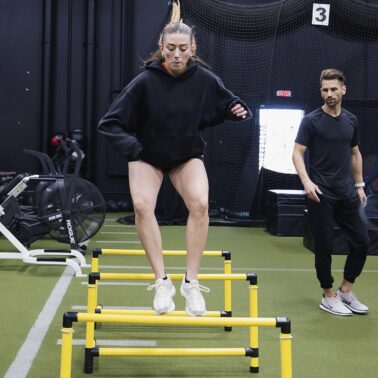“Wearable technology has become a mainstay in human performance. The key is being able to find the right solution that provides actionable, meaningful results.”
Adam Loiacono
What You Will Learn
- The history of wearable technology.
- How wearables are utilized within sports performance.
- Challenges and considerations when utilizing wearable technology.
Introduction
The world of sports has always been a fertile ground for innovation, especially in the realm of technology. Wearable technology, in particular, has revolutionized the way athletes train, compete, and improve. This article dives into the evolution and impact of wearable technology and data integration in sports performance. We’ll explore how these technologies have transformed from simple step counters into sophisticated systems capable of optimizing an athlete’s performance and health.
The Rise of Wearable Technology in Sports
Evolution of Wearable Technology in Sports
- Early Innovations: The initial phase of wearable technology in sports was quite rudimentary, marked by devices like pedometers. These simple gadgets offered basic functionalities, such as counting steps, which gave athletes a rough idea of their activity levels but lacked depth and precision.
- Technological Advancements: Over time, the industry witnessed a technological revolution. The introduction of more sophisticated devices, such as GPS trackers and heart rate monitors, marked a significant leap. These gadgets began providing more detailed insights, enabling athletes and coaches to analyze performance with greater accuracy.
- Integration with Training Regimes: The incorporation of wearable technology into regular training routines has been a game-changer. Athletes now have access to data that was previously unattainable, such as detailed movement analysis, physiological responses during different phases of training, and recovery metrics. This data-driven approach has optimized training and enhanced performance.
Current Landscape
- Diverse Range of Devices: Today’s market is flooded with an array of wearable devices, each catering to specific aspects of an athlete’s performance. From measuring stride length and cadence in runners to monitoring the force of impact in contact sports, these devices offer a granular view of an athlete’s performance.
- Smart Fabrics: One of the most innovative developments in this space is the creation of smart fabrics. These fabrics are embedded with sensors that seamlessly integrate with the athlete’s gear, providing real-time data without any discomfort or restriction of movement. This technology has been particularly transformative in sports where freedom of movement is crucial.
- Environmental Data Collection: Modern wearable devices not only focus on the athlete’s physical state but also collect data about their environment. This includes factors like temperature, altitude, and humidity, which can significantly affect performance. Understanding these environmental impacts allows for more tailored training programs.
Future Prospects
- Personalized Training and Health Management: The future of wearable technology in sports is likely to focus on personalization. With advancements in AI and machine learning, wearable devices could provide more individualized feedback, optimizing training and health management for each athlete.
- Injury Prevention and Recovery: Future wearables might predict and prevent injuries by identifying stress patterns and physiological limits. They could also play a critical role in rehabilitation, offering real-time feedback on recovery progress.
- Enhancing Viewer Experience: Beyond aiding athletes, wearable technology could transform how audiences experience sports. By integrating biometric data into live broadcasts, viewers could gain a deeper understanding of the athletes’ efforts and challenges during a performance.
Wearable technology in sports has evolved from basic step-counting devices to sophisticated systems that provide comprehensive insights into an athlete’s performance and health. Its future promises even greater personalization, injury prevention, and an enhanced viewing experience for sports fans, albeit with growing concerns about data privacy and ethical use.
Turning Data into Decisions
- Comprehensive Data Collection: Modern wearable technologies are equipped with a wide array of sensors that collect diverse data types. This includes physiological data (like heart rate and muscle oxygen saturation), biomechanical data (such as acceleration, stride length, and joint angles), and environmental data (like humidity and altitude). The richness of this data allows for a holistic view of an athlete’s performance and condition.
- Real-Time Monitoring and Feedback: The ability to monitor data in real time is a game-changer. It allows for immediate adjustments during training or competition. For instance, if a runner’s heart rate exceeds a certain threshold, they can be alerted to adjust their pace, reducing the risk of overexertion.
- Long-Term Trend Analysis: Beyond immediate feedback, long-term data collection enables the identification of trends and patterns. This can be crucial in planning training cycles, tapering before events, and managing recovery periods.
The Role of AI and Machine Learning
- Pattern Recognition and Predictive Analytics: AI and machine learning algorithms excel at identifying patterns in large datasets. In sports, this can mean detecting subtle changes in an athlete’s performance or physical condition that might indicate the onset of fatigue, overtraining, or injury risk.
- Strategic Decision-Making: In team sports, AI-driven analysis of wearable data can inform strategy. For instance, analyzing team tactics can help develop strategies that exploit opponents’ weaknesses or enhance a team’s performance.
- Enhancing Mental Training: Wearable tech is increasingly looking into psychological aspects, like stress levels or mental readiness, providing a more comprehensive approach to athlete preparation.
Ethical and Practical Considerations
- Data Privacy and Security: As wearable tech collects sensitive personal data, ensuring privacy and securing this data against breaches is paramount. Athletes and teams must be aware of who owns the data and how it’s used.
- Accuracy and Reliability: The effectiveness of data-driven decisions hinges on the accuracy and reliability of the sensors and algorithms used. Continuous validation and calibration are necessary to maintain trust in these tools.
- Interdisciplinary Collaboration: Effective use of wearable tech data requires collaboration between sports scientists, coaches, and data analysts. An interdisciplinary approach ensures that insights are not only accurate but also relevant and actionable in a sports context.
In conclusion, the transformation of raw data into actionable decisions through AI and machine learning represents a significant leap in sports technology. This not only enhances performance and strategy but also opens new frontiers in personalized training and injury prevention. However, these advancements must be balanced with ethical considerations and collaborative approaches to maximize their potential and ensure their responsible use.
Impact on performance and rehab
enhanced individualization
- Individualized Performance Metrics: Wearable technology enables the tracking of specific metrics tailored to each athlete’s sport, position, and personal goals. For a sprinter, this might mean focusing on acceleration and stride length, while a swimmer may track stroke efficiency and underwater phase duration.
- Dynamic Training Adjustments: Data from wearables allows for dynamic adjustments in training. If an athlete is not responding as expected to a particular training stimulus, coaches can quickly alter the regime based on real-time feedback, ensuring optimal training efficiency.
- Long-Term Development Tracking: Coaches and athletes can track progress over longer periods, identifying what training methods yield the best results for the individual. This historical data becomes invaluable for planning future training cycles and setting realistic performance goals.
Injury Mitigation and Management
- Early Warning Signals: Wearable tech can provide early warnings of potential injury risks by detecting abnormalities in movement patterns or physiological markers, such as elevated resting heart rate or low heart-rate variability, which may indicate fatigue or overtraining.
- Load Management: Monitoring training load is crucial in preventing overuse injuries. Wearables can quantify training load and stress, helping to balance training intensity with adequate recovery.
- Rehabilitation Tracking: During the rehabilitation process, wearables can track an athlete’s return to their baseline levels, ensuring a safe and efficient return to full training and competition.
Real-time Performance Adjustments
- In-Moment Feedback for Athletes: Wearables provide athletes with immediate feedback. For instance, a runner may receive alerts about their pace or heart rate, enabling them to adjust their effort instantaneously.
- Strategic Decision-Making in Competition: In sports like cycling, real-time data from power meters and heart rate monitors inform athletes about when to conserve energy and when to push harder, which can be crucial in race scenarios.
- Team Sports Dynamics: In team sports, wearables can provide data on player positioning, distance covered, and sprint counts. This information can be used to make strategic changes for future games.
In summary, wearable technology in sports is revolutionizing training personalization, injury mitigation, and real-time performance adjustments. The future holds immense potential for even more tailored and effective training regimes, though this must be balanced with considerations of data management, privacy, and ethical use.
Challenges and Considerations
Privacy and Security Concerns
With the accumulation of sensitive personal data comes the issue of privacy. Athletes and teams must ensure that their data is securely stored and used ethically.
Data Reliability and Accuracy
The accuracy and reliability of data from wearable devices are crucial. Misinterpreted data can lead to incorrect training adjustments or misdiagnosis of potential injuries.
Ethical Considerations
There’s an ongoing debate about the fairness and accessibility of these technologies. High-end devices might not be accessible to all athletes, potentially creating disparities in competitive sports.
Conclusion
The integration of wearable technology and data analysis in sports is not just a trend; it’s a paradigm shift. As these technologies continue to evolve, they promise even greater insights and innovations in sports performance. The future may bring more advanced sensors, more intuitive AI analyses, and perhaps a new era of hyper-personalized, data-driven training and competition. What remains clear is that the intersection of technology and sports will continue to be an exciting and transformative frontier.



